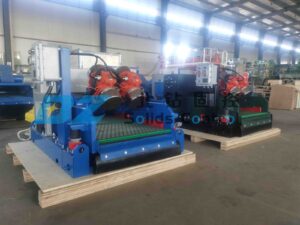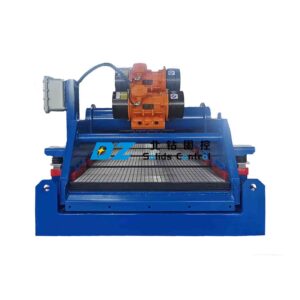How to deal with the slurry run-out phenomenon of the drilling fluid linear shale shaker?
What should I do if the drilling fluid linear shale shaker is running out of mud during the processing of the drilling fluid? It is understood that this is mainly related to factors such as high solid content in the drilling fluid, high mud viscosity, and dispersion of drill cuttings; it is related to the small vibration force of the drilling fluid shale shaker, high mesh number, and small screen area. It is related to its own conditions; it also has a lot to do with the direction and position of the liquid inlet of the shale shaker during on-site installation. It can be analyzed step by step from the following points.
 Drilling fluid linear shale shaker
Drilling fluid linear shale shaker
1. Regularly check the rotation of the motor. First remove the vibrator shield and check whether the eccentric blocks of the two motors rotate outwards. Secondly, if the steering is wrong, please exchange any two phase wires in the incoming power supply of the electric control box. The first error method (two motors rotate towards the inside), although the drill cuttings can also be removed outwards, but the speed is slow; the second error method (two motors rotate in the same direction), the vibration force is very small, and basically does not discharge sand or dispose of mud .
2. The mesh number of the screen is unreasonable. Due to the rapid drilling of the surface layer, the solid phase generated takes up the effective screen area, so the shale shaker cannot use the fine screen in the shallow well section. Therefore, a larger-hole screen should be used at the beginning of drilling, and as the drilling depth increases, finer screens should be gradually adopted.
3. The formation and mud conditions affect the processing capacity. Since the drugs added in the drilling fluid have not been fully dissolved and the paste is on the screen, serious slurry running will occur at this time. You should wait until the drug is fully dissolved before using it, or use a larger mesh screen. On the other hand, when drilling into a loose sand-bearing layer or quicksand layer, the sand particles are likely to get stuck in the screen holes, causing screen plugging. Therefore, it is necessary to test several screens with different meshes to reduce the blocking phenomenon.
4. Check the amplitude of the shale shaker. The larger the vibration amplitude is, the more general processing capacity is; the vibration force is adjusted to 90% when leaving the factory. If there is a situation of running pulp, you can align the inner and outer eccentric block angles, then the vibration force is. (At this time, the mud processing volume only increases by about 15%)
5. Check whether the liquid flow distribution on the screen frame is reasonable. For the shale shaker with a hook-side screen structure, the screen surface on both sides is lower than the middle, and the mud is easy to flow to both sides and lose. It should be ensured that the mud enters the screen frame from the middle. At this time, two solutions can be adopted. One is to adjust the front spring seat to appropriately raise the angle of the front of the screen box; the other is to adjust the position of the turning plate of the extension slot to control the distribution of liquid flow.

